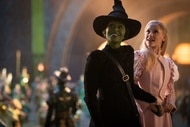Create a free profile to get unlimited access to exclusive videos, sweepstakes, and more!
Here's how Nia DaCosta's 'Candyman' pulled off that powerful shadow puppetry

"A story like that... pain like that... lasts forever. That's Candyman."
Last June, writer/director Nia DaCosta teased her upcoming Candyman film (now playing) with a rather unique bit of footage that wordlessly tracked the history of racial injustice in the United States. Running for close to three minutes, the video showcased a number of harrowing instances of bigotry and racist violence depicted via the art form of shadow puppetry. Some of this work ended up in the finished film during the scene in which Cabrini Green old-timer William Burke (Colman Domingo) recounts the tragic story of Daniel Robitaille (the original Candyman) to artist Anthony McCoy (Yahya Abdul-Mateen II).
The shadow puppets were handled by Manual Cinema, a Chicago-based performance collective that was asked to help out with the movie's production all the way back in 2019.
"We were recommended by production designer Cara Brower," co-artistic director and line producer Julia Miller exclusively tells SYFY WIRE. "So, we basically got a cold call to create some puppet-animated sequences for the film. As we started working and creating material, that content just began to grow and encompass other sections and just sort of expanded... We’ve worked on more independent films before, but this is the largest project of this kind, of this scale, for us."
DaCosta and the producers closely collaborated with Manual Cinema over the course of several months "to land on what the aesthetic of the puppetry was," Miller, who also edited the puppet-based teaser, explains. "Developing what that visual vocabulary would be, especially because the main character is a painter and we reference that character in the animation. So, we were rendering things that already had been rendered in other formats in the film."
The production team also looked at the iconic 1992 original (directed by Bernard Rose and starring Tony Todd) in the hopes of providing a bit of subtle connective tissue between the first movie and DaCosta's direct sequel.
"We’re definitely within the lineage or history of the film," Miller adds. "We’re definitely building upon the legacy that the original film began and in conversation with it, for sure. I personally cannot watch horror movies and had to, secondhand, hear about content because I’m a scaredy-cat and can’t watch stuff like that. But yeah, our designers, Drew Dir and Lizi Breit — who created all the puppetry and set pieces for the film — they definitely were referencing the original movie and building that into the design."
It may be hard to believe this in a world so inundated with CGI effects, but the shadow puppets were 100 percent practical. "All the puppets are made out of paper and they have wire armature and little joints," Miller says. "They’re all manually operated and we used several different types of screens, but it’s all shadow. We had puppets against either a paper screen of vellum or a fabric screen, and we used different lighting effects to either emulate fire or different light... We [also] all used cinematic vocabulary like the tracking shots or pans or the camera pushing in on the fixed set elements... There are certain things in our vocabulary that translate and there’s also learning a whole new vocabulary of how to work with producers and editors and VFX and all the post-production things. It was a new world for us a little bit."
She continues: "We shot it in-house and worked with a DP that we’ve worked with a lot over the years, Andrew Morgan, who has a company called Little Cabin Films. We’ve been developing all these new techniques and styles for filming puppetry, so creating puppetry for film. He’s been with us as we’ve been learning and experimenting and trying new things. We have a really great relationship in trying to experiment and find out new ways to shoot puppetry for film."
While Candyman would eventually have its theatrical release delayed to late August 2021 by the COVID-19 pandemic, the shadow trailer could not have come out at a more relevant time. In addition to the global health crisis, last summer was also defined by worldwide protests against racism in the wake of George Floyd's death at the hands of Minnesota police officers.
"I can’t speak to the decision-making process on the production side, but I know that this conversation started within the last couple weeks and was not part of the initial rollout of the film," Miller reveals. "[It] came out of… how topical the content was and that we’d already created it for the project and it seemed like an opportune moment to release it into the world in this small capsule."
Candyman is now playing in theaters everywhere. The film debuted at No. 1 at the North American box office this past weekend with just over $22 million in ticket sales. It made history as the very first film directed by a Black female filmmaker to open in the top domestic spot. Globally, Candyman is already closing in on $30 million.
(Universal Pictures & SYFY WIRE are both owned by NBCUniversal)





























